
Ideal Diet for a Pug
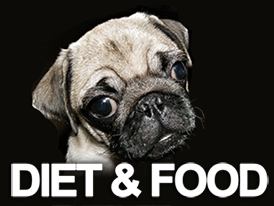 One of the best ways that you can spoil your beloved Pug and feel good about it is with a healthy and nutritious diet. A good healthy diet will not only make your four legged friend happy – but it will also benefit his health and mood!
One of the best ways that you can spoil your beloved Pug and feel good about it is with a healthy and nutritious diet. A good healthy diet will not only make your four legged friend happy – but it will also benefit his health and mood!
Why Diet is So Important
I’m sure most of you already understand the important of a healthy diet for your Pug. It plays a role in his mood, energy, appearance and of course his overall health in general. These dogs have their own genetic health concerns – bulging eyes, wrinkly face, etc. – but I would argue that understanding your Pugs particular nutritional needs is just as important, if not more so. And there is a very simple reason why.
The current problem is that there is a lot of food out there that’s… well… not so great to say the least. It might fill up your pooch but it won’t provide him with the nutrition that he needs. This could mean weakened immune system, more health related problems, stomach problems, more shedding, etc.
And it’s not just the quality of the food that can cause problems, but also the amount. Obesity is a serious problem among smaller dog breeds. It’s easy to overfeed these little guys due to their unstoppable appetite and small size.
Related Article: How much should I feed my Pug
Ideal Diet for a Pug
I’m going to state the obvious here, at their very core these dogs are still carnivores. Not very good hunters I would argue, but they still need meat. Their digestive system is not built for a vegetarian or vegan diet – although they can still benefit from vegies and fruits. They just can’t eat vegetables exclusively.
In fact, certain fruits and vegetables can be added for their vitamins and minerals. Things like broccoli, carrots, green beans all make great additions to a meal. For those of you who prepare the food yourselves, there is a lot for you to work with. And to make up for any deficiencies, there is a wide variety of supplements you can give him – we will discuss this s little more further down the page.
As to the exact nutritional values and ratios, I can’t really help you there without knowing your dog – which is why I always tell everyone to check with the vet. What might work for one Pug might not for another. And what worked for a Pug puppy, won’t be ideal once he is fully grown – and when he gets old his dietary requirements will change again!
What I WOULD like to discuss with you are the different options that are available to you. That way when you do talk to your Pug’s vet, you will understand what he or she is talking about.
Those options break into two categories – home cooked and store bought.
Home Cooked Meals
Preparing the meals, yourself is the most flexible and arguably best option. Since you will be the one cooking, you will know the exact type and quality of the ingredients used. Plus it’s the best tasting option here. You don’t even have to be a good chef, trust me – your Pug will gobble it up.
There are hundreds of recipes for homemade dog food available to pick from – and they’re easy to make too. You can just make a weeks’ worth at a time and just store it in the fridge so you don’t have to prepare them every day. Most of the ingredients are basic that you probably buy already anyways. Popular ingredients include:
- Chicken
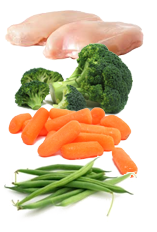
- Lamb
- Beef
- Brown Rice
- Broccoli
- Green Beans
- Carrots
- Cauliflower
You can even cook something up and mix it in with kibble to make it more flavorful. But if this is not an option for you, don’t worry. You can still buy something healthy. Also if you do decide to cook yourself, you will probably need some sort of supplements. Again talk to a vet that knows your Pug.
Store Bought Food
When it comes to store bought food, the quality ranges from really good and notorious to something you’d expect to find in a dumpster. Don’t be fooled by pretty pictures or nice labels, you have to do your own research here. Check out all the ingredients on the back of the label and then do some research on the brand itself. It sounds like a lot of work, but trust me its research you’ll be glad you did. A good place to start is Dog Food Advisor.
I’m not trying to scare you, but if you’re going to buy the same brand of food for your Pug to eat for the majority of his life – you might as well check what’s in it for your own peace of mind. I would also suggest that you bookmark the FDA Animal Food Recall Page. It will give you a better idea of what brands to avoid.
Again, not all store bought dog food is bad. There are a lot of great options for your Pug. If you have any good brand suggestions, feel free to leave them in the comments section below.
Dry Kibble
Dry kibble is super convenient. It doesn’t go bad quick, so you can buy a lot at a time. There are a lot of brands to choose from and it’s less expensive than canned food. So no wonder it’s the most popular dog food. It is the simple and easy solution for most owners.
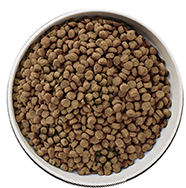 The problem is that it’s not the most appetizing thing in the world – but your Pug will probably eat it anyway. The hard dry texture also has some dental benefits. Since it’s hard, your Pug will have to work his little teeth to chew his food. As a result, he will be stimulating his gums and teeth during every meal – which is a great plus, but not an excuse to forget about dental health completely.
The problem is that it’s not the most appetizing thing in the world – but your Pug will probably eat it anyway. The hard dry texture also has some dental benefits. Since it’s hard, your Pug will have to work his little teeth to chew his food. As a result, he will be stimulating his gums and teeth during every meal – which is a great plus, but not an excuse to forget about dental health completely.
The Pros
- usually cheaper
- can be stored for longer
- hard texture is good for teeth
The Cons
- not that appetizing
- hard to chew for Pugs with dental problems
Wet Canned Dog Food
Then there is the “wet food” – basically dog food from a can. Nine out of ten times your Pug will go for this over kibble. As soon as you open the can, you will see him drooling over it. It smells good, tastes good and it’s easy to swallow down the whole bowl – what’s not to like?
Well one of the possible downsides is that it’s just too soft and there really isn’t much for him to bite his teeth into. Which isn’t too big of a deal as long as you give him something he can chew on afterwards. And the reason I said “possible” downside is because it could be a benefit in certain situations.
If your Pug is really old or has dental problems that make it painful or difficult for him to bite or chew – then wet food would be a much better option over dry hard kibble.
The Pros
- More appetizing
- Good for Pugs that can’t chew
- Often times better ingredients
The Cons
- More expensive
- Can’t store it for as long
- Will need to supplement with chewy treats/toys for dental health
Supplements
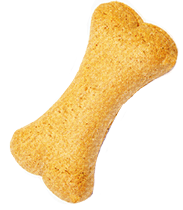 There is a huge variety of all sorts of supplements target at dogs. Maybe even too much variety. Before you go out and spend your hard earned money on supplements that your Pug might not even need, you should first talk to your vet.
There is a huge variety of all sorts of supplements target at dogs. Maybe even too much variety. Before you go out and spend your hard earned money on supplements that your Pug might not even need, you should first talk to your vet.
Again, every dog is unique – even within the Pug breed. Pug puppies will need different nutrition than a senior. So there is no one answer that fits everyone. Having said that, I still think that supplementing your Pug’s food is a must – especially if you’re preparing the food yourself.
Learn More: Best treats to give to a Pug
Additional Tips
Here are some additional tips to keep in mind:
Tip #1: Make sure water is available at all times – Your Pug should have fresh clean water available to him at all times.
Tip #2: When switching food do it slowly – When changing foods, slowly introduce by mixing it in with some of the old food. It will make the transition smoother. Drastic changes can upset his tummy.
Tip #3: It’s all about the smell – Believe it or not, your Pugs sense of taste is actually not that good. It’s the smell that they go by. So if you need him to eat something, best way to get him to eat it is to add something else that smells yummy.
Tip #4: Watch your dog’s weight – The combination of huge appetite and small size makes it easy to overfeed him. Watch the weight to make sure he’s in the healthy weight range. Pugs that exceed the recommended weight tend to have more health problems down the road.
Tip #5: Always consult a vet – This is especially true if you decide to prepare his food yourself. It’s easy to miss or overlook something important. Before you make any changes always consult a vet.
PUG PERFECT
The complete guide to owning a Pug. Learn what it takes to make your Pug happy, healthy and happy – Learn More












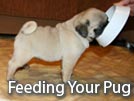
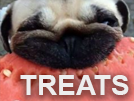

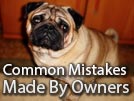
Leave a Reply